A Study on Environmental Sustainability of Bulgarian Farming Enterprises
Hrabrin Bachev*
1The Bulgarian National Science Fund has supported this research, Europe
2Institute of Agricultural Economics, Bulgaria, Europe
Submission: October 01, 2017; Published: October 20, 2017
*Corresponding author: Hrabrin Bachev, Institute of Agricultural Economics, Bulgaria, Europe, Tel: (359] 884 187358; Email: hbachev@yahoo.com
How to cite this article: Bachev H. A Study on Environmental Sustainability of Bulgarian Farming Enterprises. Int J Environ Sci Nat Res. 2017; 6(1): 555676. 555676. DOI:10.19080/IJESNR.2017.06.555676
Abstract
The issue of assessment of diverse aspects of sustainability of farming enterprises is among the most topical in the last decades around the globe. Nevertheless, in Bulgaria there are no comprehensive studies on environmental sustainability of farms in general or of different types. This article applies a holistic framework for assessing environmental sustainability of Bulgarian farming enterprises. Firstly, multi principle, multi criteria and multi indicator frame work for assessing environmental sustainability of farm in the country is outlined. After that the level of environmental sustainability of farming enterprises in Bulgaria is evaluated in general and of farms different juridical type, size, production specialization, and ecological and administrative location. Finally, relations between environmental and socio-economic and integral sustainability of Bulgarian farms are specified.
Keywords: Environmental sustainability; Farms and Bulgaria
Introduction
The issue of assessment of diverse (social, economic, environmental, etc.) aspects of sustainability ofagricultural farms is among the most topical in the last decades [1-13]. Nevertheless, with a very few exceptions [14-16] in Bulgaria there are no comprehensive studies on environmental sustainability of farms in general or different types. Furthermore, most assessment does not study important relations between environmental and other (governance, social, economic, etc.) aspects of farm sustainability. This article applies a holistic framework for assessing environmental sustainability of Bulgarian farms. Initially the method of the study is outlined. After that an assessment is made of level of environmental sustainability of farms in general and of different juridical type, size, production specialization, and ecological and administrative location. After that, relations between environmental and socio-economic and integral sustainability is specified. Finally, factors for improving environmental sustainability of Bulgarian farms are identified.
A Holistic Framework of Analysis
Sustainability characterizes the ability (capability) of a particular farm enterprise to exist in time and maintain in a longterm its diverse (governance, economic, ecological and social) functions in the specific socio-economic and natural environment in which it operates and evolves [2]. Farm sustainability has four aspects (pillars), which are equally important - governance, economic, social and environmental. A farm is environmentally sustainable if its activity is associated with the conservation, recovery and improvement of the components of natural environment (lands, waters, biodiversity, atmosphere, climate, ecosystem etc.) and the nature as a whole, animal welfare, etc. In this study we apply a hierarchical framework for assessing environmental sustainability of Bulgarian farms including 6 Principles, 12Criteria, and 22 Indicators and Reference Values (Figures 1 & 2). The hierarchical levels, which facilitate the formulation of the system for assessing environmental sustainability includes: Principles - the highest hierarchical level associated with the "environmental preservation" function of the agricultural farms. They are universal and represent the states of the sustainability, which are to be achieved in the environmental aspect of farm sustainability.
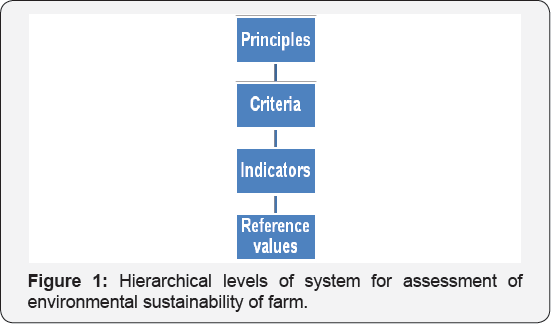
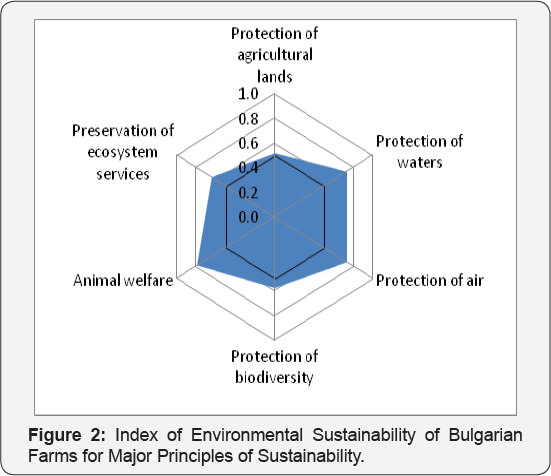
For instance, a Principle "the soil fertility is maintained or improved". Criteria - they are more precise from the principles and easily linked with the sustainability indicators, representing a resulting state of the evaluated farm when the relevant principle is realized. For instance, a Criteria "soil erosion is minimized" for the Principle "the soil fertility is maintained or improved" Indicators are quantitative and qualitative variables of different type (behavior, activity, input, effect, impact, etc.), which can be assessed in the specific conditions of the evaluated farms, and set of indicators is to provide a representative picture for the farm's environmental sustainability for instance, an Indicator "the extent of application of good agro-techniques and crop rotation" for the Criteria "soil erosion is minimized"
Reference value - these are the desirable levels (absolute, relative, qualitative, etc.) for each indicator for the specific conditions of the evaluated farms. They assist the assessment of environmental sustainability level and give guidance for achieving (maintaining, improving) farm sustainability. They are determined by the science, experimentation, statistical, legislative or other appropriate ways. First of all we have profoundly studied out the available academic publications, official documents, and experiences in Bulgaria and other countries as well as carried our numerous consultations with the leading national and international experts in the area of environmental sustainability of farms. On that base we have prepared a list (system) with potential principles, criteria, indicators and reference values for the contemporary socioeconomic and natural environment of Bulgarian farms. After that we organized a special expertise with ten leading scholars working on environmental sustainability of the farms. The experts discussed, complemented and evaluated the importance of the suggested by us principles, criteria, indicators and reference values for assessing environmental sustainability of Bulgarian farms, and selected the most adequate ones for the contemporary conditions of the development in the country (Table 1).
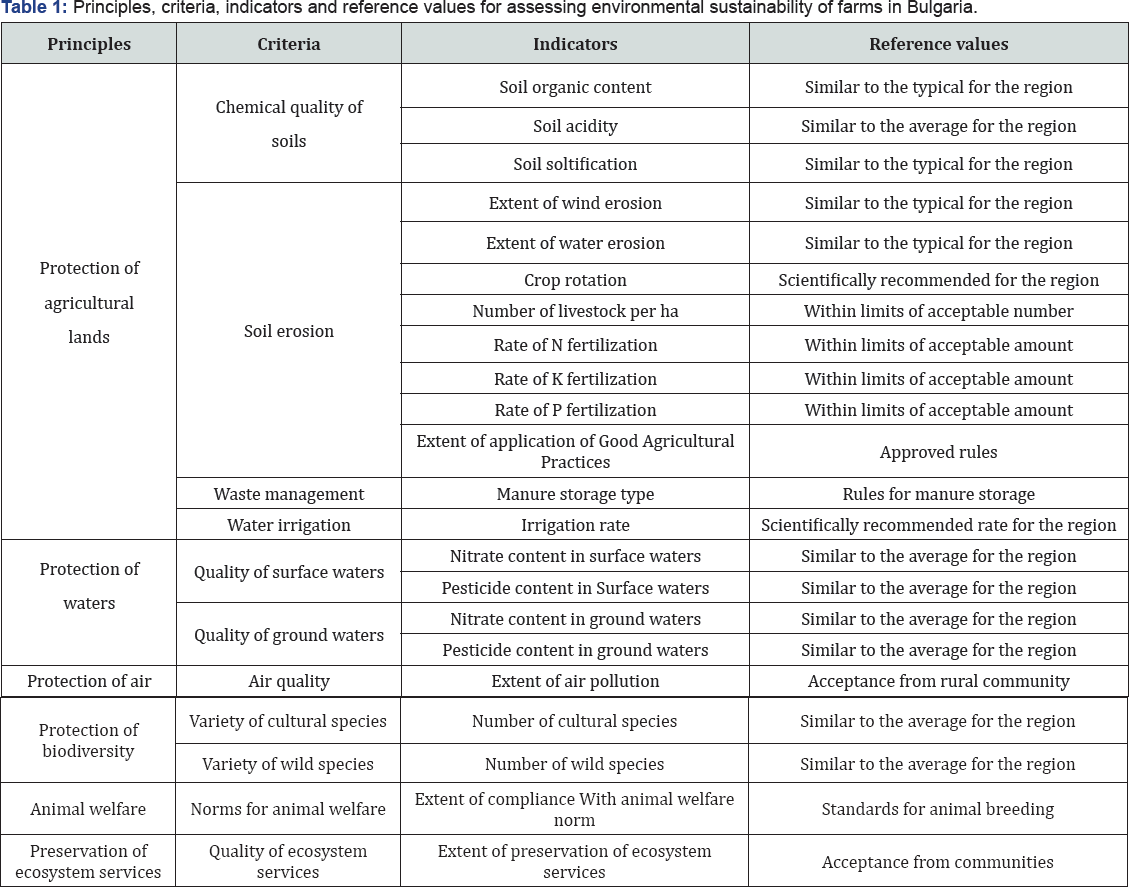
Assessment of environmental sustainability of farms in the country is based on a large-scale survey with the managers of "representative" market-oriented farms of different type. The survey was carried out in the summer of 2016 with the assistance of the National Agricultural Advisory Service and the major associations of agricultural producers in the country, which identified the "typical" holdings of different type and location. The survey included 190 registered agricultural producers, which comprise around 0,2% of all registered agricultural producers in Bulgaria . The structure and importance of surveyed farms approximately corresponds to the real structure of registered agricultural producers and market-oriented holdings in the country.
Assessment of sustainability level of individual farm is based on estimates of the managers for each Indicator in four qualitative levels: "High/Higher or Better that the Average in the Sector/Region", "Similar/Good", "Low/Lower or Worse than the Average in the Sector/Region", "Negative/Unsatisfactory/ Unacceptable". After that the qualitative estimates for individual farms were quantified and transformed into Sustainability Indexes for each Indicator (SI(i)) using following scales: 1 for "High", 0,66 for "Good or Average", 0,33 for "Low", and 0 for "Unsatisfactory or Unacceptable". For classification of farms according to juridical type (Physical Person, Sole Trader, Cooperative, Company), production specialization (Field Crops, Vegetables, Flowers, and Mushrooms, Permanent Crops, Grazing Livestock, Pigs, Poultry, and Rabbits, Mix Crop-Livestock, Mix Crops, Mix Livestock), geographical and administrative regions (North-West Region, North-Central Region, North-East Region, South-West Region, South-Central Region, South-East Region), and ecological locations (Mountainous or Non-mountainous regions with Natural Handicaps, with Lands in Protected Zones and Territories) the official typology for farming holdings in the country is used.
In addition, every manager self-determined his/her farm as Predominately for Subsistence, rather Small, Middle size or Large for the sector, and located mainly in Plain, Plain-mountainous or Mountainous region. The latter approach guarantees an adequate assessment since the farms managers are well aware of the specificity and comparative characteristics of their holdings in relations to others in the region and the (sub) sector. For the integral assessment of sustainability of a farm for every Criteria, Principle, and Aspect, equal weights are used for each Principle in a particular Aspect, and for each Criterion in a particular Principle, and for each Indicator in a particular Criterion.
Overall Sustainability of Farming Enterprises
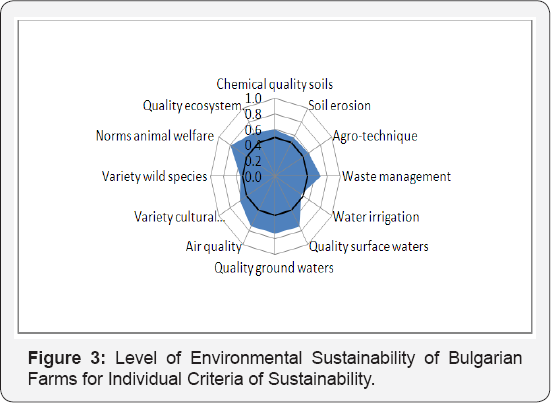
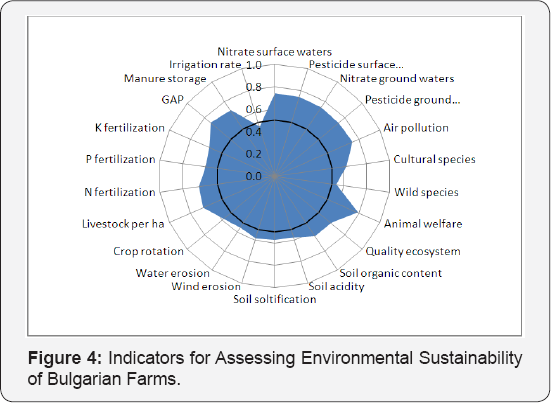
Multi-indicators assessment of sustainability of surveyed farms indicates that Environmental sustainability is at a good level with an Index of Environmental Sustainability of 0,61. Analysis of individual Indexes for major sustainability Principles, Criteria and Indicators let identify components contributing to diverse aspects of farms' environmental sustainability in the country. For instance, it is clear that despite that the overall environmental sustainability is relatively high, the Index of Preservation of Agricultural Lands (0,52) and the Index of Preservation of Biodiversity (0,56) are relatively low and critical for maintaining the achieved level. In depth analysis for individual Criteria and Indicators further specifies the elements, which enhance or reduce farms' environmental sustainability level. For instance, inferior levels of the Preservation of Agricultural Lands and the Preservation of Biodiversity are determined accordingly by insufficient Application of Recommended Irrigation Norms (0,46), high level of Soils Water Erosion (0,55), and lowered Number of Wild Species on Farm Territory (0,53) (Figures 3 & 4).
Low levels of sustainability indicators identify the specific areas for improvement of environmental sustainability of farms through adequate changes in management strategy and/or public policies. For instance, despite that the overall Environmental sustainability of Bulgarian farms is relatively high, the indicators for Irrigation rate, Wild species on Farm, Water erosion,Soil acidity and Soil soltification, and Wind erosion area relatively low (Figure 4). Therefore, effective measures are to be undertaken to improve the latter through education, training, information, amelioration of agro-techniques, structure of production and varieties, technological and organizational innovations, etc. On the other hand, superior levels of certain indicators show the absolute and comparative advantages of Bulgarian farms related to sustainable development. At the current stage of development the latter are associated with respecting Animal Welfare standards, Preservation of Quality of Surface and Ground Waters from contamination with nitrates and pesticides, Preservation of Air Quality, implementation of Good Agricultural Practices, and reduced Number of Livestock per unit of Farmland.

There is a great variation in sustainability levels of farms of different type and location (Figure 5). Only holdings specialized in Mix livestock are with a low environmental sustainability (0,41). Furthermore, some categories of farms are with an environmental sustainability on or close to the border with inferior level. In the latter group are holdings specialized in Vegetables, Flowers and Mushroom sand Field Crops, as well as farms located in the North-West region of the country. For all these holdings effective measures have to be undertaken for improving environmental and overall sustainability.
With the best environmental sustainability are Companies, and holdings specialized in Pigs, Poultries and Rabbit, Mix Crop- livestock production, and those located in Less-favored non- mountainous of the country. The "environmental pillar" is only one of the four major aspects ("pillars") of farms sustainability, both adversely affecting or enhancing the overall (integral) sustainability of holdings [4]. Therefore, we have to evaluate all four dimensions of farm sustainability, and specify relations between different pillars and with the integral sustainability level. Our survey has found out that the Index of Integral Sustainability of Bulgarian harms is 0,55 - that suggests a good level of overall sustainability of agricultural holdings in the country (Figure 6). With the highest levels are Indexes of Environmental (0,61) and Social (0,57) Sustainability of farms, while Indexes of Governance (0,52) and Economic (0,5) Sustainability are at the border with a low level . Therefore, improvement of the latter two is critical for maintaining a good sustainability of farming enterprises in the country. Consequently, if farms do not have a sufficient aspect's(s') or the overall sustainability, they will not be environmentally sustainable as well since they will fail, merge, taken over, or leave the farming business.

Analysis of individual Indexes for major sustainability Principles, Criteria and Indicators let identify components contributing to diverse aspects of the overall farms' sustainability in the country. For instance, governance and economic sustainability of Bulgarian farms are relatively low because of the fact that the Index of Governance Efficiency (0,49) and the Index of Financial Stability (0,47) of holdings are low. Therefore, such "critical points" are to be improved (e.g. improving farms adaptability to changes in the natural environment) in order to maintain the overall sustainability of farms in the country, which otherwise are characterized with a relatively high environmental sustainability.
Environmental Sustainability for Farms of Different Type
There is a great variation in the levels of the individual environmental sustainability indicators for farms of different juridical type in the country - Physical (Natural) Persons, Sole Traders, Cooperatives, and diverse kind of Companies, and (Figure 7). Most sustainability indicators of Physical Persons are low and lead to a decrease in sustainability for the environmental aspect and the overall sustainability level. In the environmental plan sustainability is low in respect to complying with norms for Number of Livestock per ha (0,39), Type of Manure Storage (0,39), Extent of Respecting Animal Welfare (0,43) and Irrigation Rate (0,49). Furthermore, the integral sustainability is compromised because of the low level of the governance, economic and social sustainability. The later three are caused more specifically by the insufficient: Level of Adaptability to Natural Environment (0,49), and Comparative Efficiency of Supply and Governance of Labor Resources (0,49), Natural Resources (0,49), Long-term Inputs (0,48) and Innovations (0,49), and extremely low Comparative Efficiency of Supply and Governance of Short-term Inputs (0,26); low Livestock Productivity (0,34), Rate of Profitability of Own Capital (0,36), Overall Liquidity (0,44), and Financial Autonomy (0,48);and inferior Income per Farm-household Member (0,49). In all these directions adequate measures have to be undertaken by managers and state authority in order to improve environmental and the overall sustainability of that type of farms. At the same time, a number of indicators for environmental sustainability of Physical Persons are with relatively high positive positions within the good level - e.g. Nitrate and Pesticides Content in Surface and Ground Waters, Extent of Air Pollution, and Extent of Application of Good Agricultural Practices. All these advantages of Physical Persons are to be maintained and enhanced, while other indicators for eco-efficiency increased in order to preserve and increase the aspect and the overall sustainability of these types of holdings.
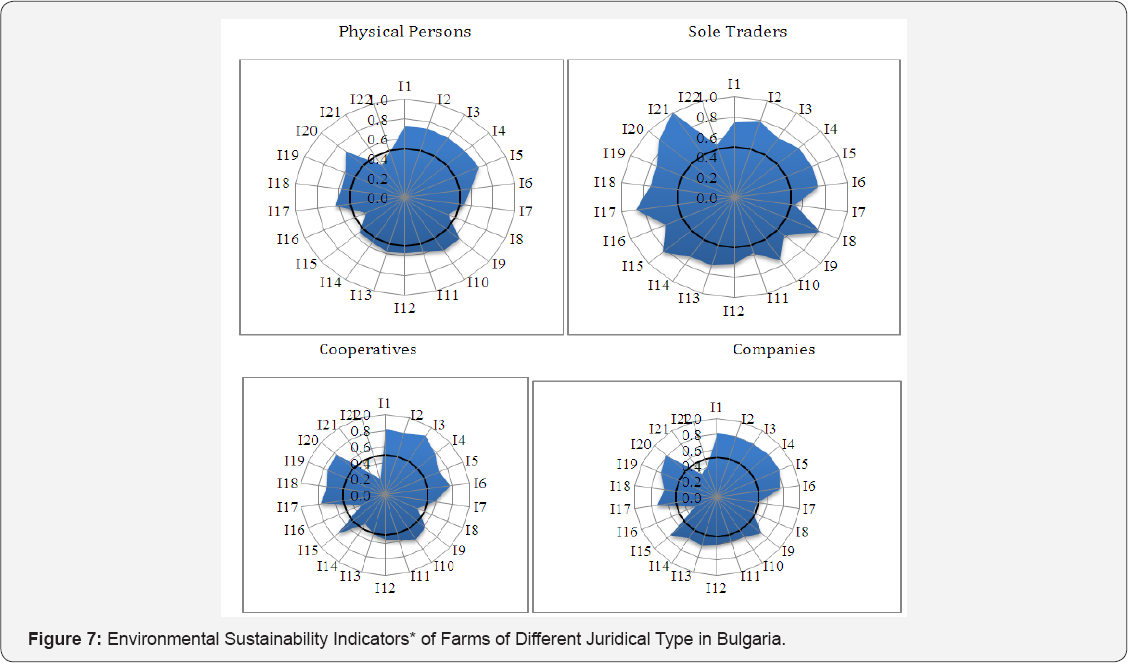
*I1-Nitrate Content in Surface Waters; I2-Pesticide Content in Surface Waters; I3-Nitrate Content in Ground Waters; 14- Pesticide Content in Ground Waters; I5-Extent of Air Pollution; I6-Number of Cultural Species; I7-Number of Wild Species; I8- Extent of Respecting Animal Welfare; I9-Extent of Preservation of Quality of Ecosystem Services; I10-Soil Organic Content; I11- Soil Acidity; I12-Soil Soltification; I13-Extent of Wind Erosion; I14-Extent of Water Erosion; I15-Crop Rotation; I16-Number of Livestock per ha of Farmland; I17-Norm of Nitrogen Fertilization; I18-Norm of Phosphorus Fertilization; I19-Norm of Potassium Fertilization; I20-Extent of Application of Good Agricultural Practices; I21-Type of Manure Storage; I22-Irrigation Rate Source: survey with farm managers, July 2016
The Sole Traders have high environmental sustainability caused by eco-friendly for activity in relation to: Type of Manure Storage, Norm of Nitrogen Fertilization, and Extent of Application of Good Agricultural Practices, and marginal to the highest level for implementation of effective Crop Rotation. What is more, holdings with livestock are with a high sustainability for Livestock Productivity as well as a marginal to the highest level for Extent of Respecting Animal Welfare Standards. Furthermore, many indicators for the environmental sustainability of Sole Traders are with high positive values within the borders of the good level: Nitrate and Pesticides Content in Surface and Ground Waters, Extent of Air Pollution, Number of Cultural Species, Soil Organic Content, Extent of Wind and Water Erosion, and application of recommended Norms of Potassium and Phosphorus Fertilization.
The Sole Traders are also with a high position, within the borders of a good level, for governance and economic sustainability particularly for: Comparative Efficiency of Supply and Governance of Long-term Inputs, Level of Labor Productivity, and Land Productivity. All that also contributes to a growth in their integral sustainability as well. Simultaneously, the Sole Traders are with low values for governance sustainability in respect to Level of Adaptability to Natural Environment (0,37) and Comparative Efficiency of Supply and Governance of Shortterm inputs (0,33), and for the social sustainability in respect to their Contribution to Preservation of Rural Communities and Preservation of Traditions (by 0,33). In the later directions a measures are to undertaken to improve aspect and the overall sustainability of these type of farming enterprises.
The cooperatives have numerous indicators for environmental sustainability with superior levels -high for Nitrate Content in Ground Waters, and good for Nitrate and Pesticide Content in Surface Waters, Pesticide Content in Ground Waters, Number of Cultural Species, Extent of Application of Good Agricultural Practices, efficient Crop Rotation, and application of Norms of Nitrogen and Phosphorus Fertilization. Furthermore, the Cooperatives demonstrate good levels for governance, social and economic sustainability particularly as far as following areas are concerned: Level of Adaptability to Market Environment, Level of Labor Productivity, Income per Farm-household Member, Contribution to Preservation of Rural Communities and Preservation of Traditions. All these positive aspects of the activity of the Cooperatives are to be maintained and expended in other to keep or improve environmental and overall sustainability of these farms.
On the other hand, the Cooperative farms are environmentally unsustainable in respect to Irrigation Rate (0,2) and with low levels for Comparative Efficiency of Supply and Governance of Short-term Inputs (0,3), Livestock Productivity (0,33), required Number of Livestock per ha (0,31), Type of Manure Storage (0,31), Extent of Respecting Animal Welfare (0,41), and Extent of Water Erosion (0,43). These parts of the Cooperatives' activity have to be considerably improved in order to increase governance, economic, environmental and integral sustainability of these enterprises. Environmental sustainability of the Companies is superior in a number of directions: Nitrate and Pesticides Content in Surface and Ground Waters, Extent of Air Pollution, Extent of Application of Good Agricultural Practices, efficient Crop Rotation, Number of Cultural Species, application of Norms of Nitrogen and Phosphorus Fertilization, and Extent of Preservation of Quality of Ecosystem Service. In addition, the Companies show good levels of governance, economic and social sustainability particularly for: Comparative Efficiency of Supply and Governance of Labor Resources, Comparative Efficiency of Governance of Marketing of Products and Services; Labor Productivity and Income of Enterprise; and Compliance with Working Conditions Standards.
With the lowest values for the Companies are indicators for environmental sustainability: permissible Number of Livestock per ha (0,29), Type of Manure Storage (0,35), Extent of Respecting Animal Welfare (0,41), Irrigation Rate (0,41) and Number of Wild Species on the Territory of Farm (0,49). Likewise, are some of the major indicators for governance and economic sustainability such as: Comparative Efficiency of Supply and Governance of Short-term Inputs (0,35) and Livestock Productivity (0,35). All these sides of the activity of corporative enterprises have to be improved in order to increase their environmental and integral sustainability. Farms with different size are characterized with a big differentiation in the levels of environmental sustainability as a whole and for the individual indicators (Figure 8).
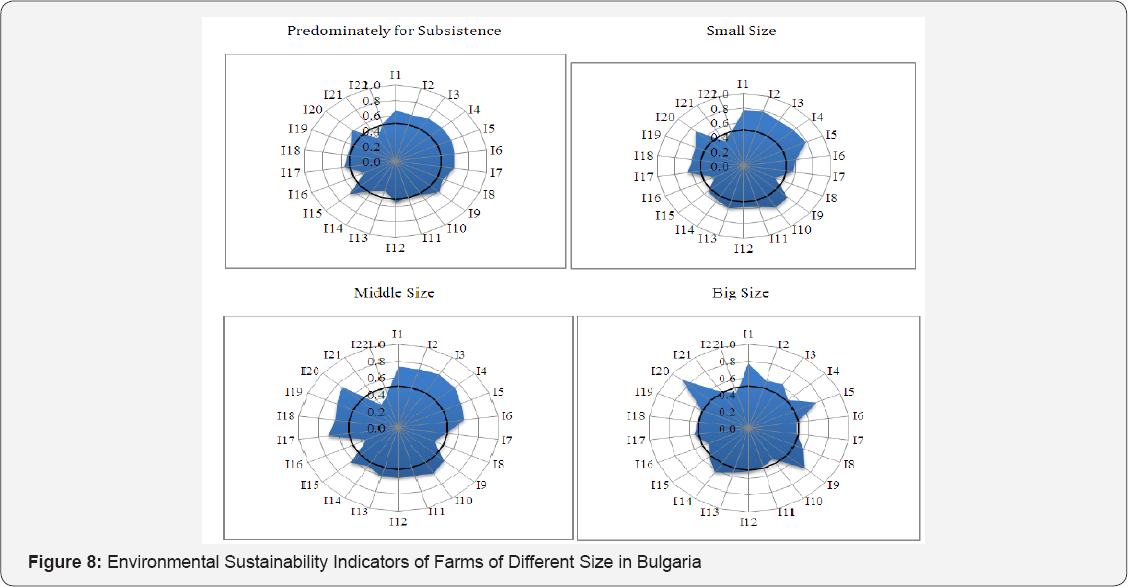
The Holdings Predominately for Subsistence have certain indicators for environmental sustainability at low levels including: Extent of Wind (0,41) and Water (0,47) Erosion, Soil Acidity (0,49), Type of Manure Storage (0,35), and Number of Livestock per ha (0,37). Furthermore, these farms are with a low Level of Adaptability to Market (0,47), Institutional (0,45), and Natural (0,45) Environment, insufficient Comparative Efficiency of Supply and Governance of Labor (0,39) and Natural (0,39) Resources, Long-term Inputs (0,37), Innovations (0,41), Finance (0,39), and Marketing of Products and Services (0,45), and they are unsustainable regarding Comparative Efficiency of Supply and Governance of Short-term Inputs (0,19). Besides, these holdings are with a low Land Productivity (0,39), Level of Labor Productivity (0,41), Rate of Profitability of Production (0,35), Income Return of Enterprise (0,43), Overall Liquidity (0,31), and Financial Autonomy (0,35), and they are unsustainable in respect to Livestock Productivity (0,17), and Rate of Profitability of Own Capital (017). Last but not least important, these holdings have inferior indicators for social sustainability like: Income per Farm-household Member (0,33), and Contribution to Preservation of Rural Communities (0,41) and Preservation of Traditions (0,49). All these compromise the environmental and overall sustainability of this type of farms in the country.
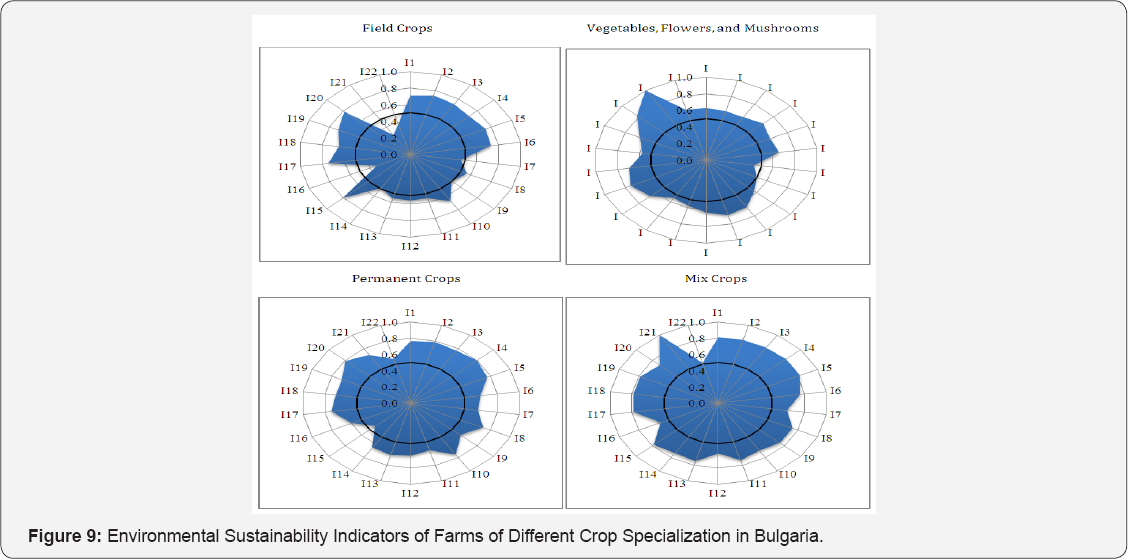
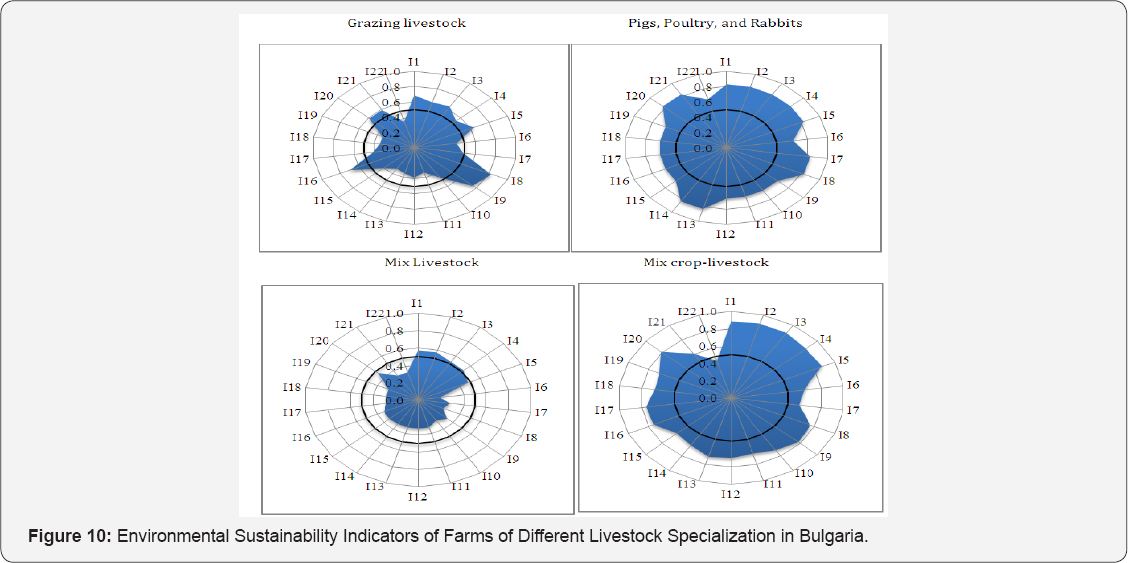
At the same time, semi market holdings have relatively high indicators, within a good level for environmental sustainability like as: Nitrate Content in Surface and Ground Waters, Pesticide Content in Surface and Ground Waters, Extent of Air Pollution, efficient Corp Rotation, Number of Cultural Species, and Number of Wild Species on the Territory of the Farm. That contributes to environmental sustainability but does not affect the integral level due to adverse effects in already pointed out areas of environmental, governance, and socio-economic performances. Farms with Small size for the sector have some parts of indicators for environmental sustainability at a relatively good level like: Extent of Air Pollution, Nitrate and Pesticide Content in Surface and Ground Waters, Extent of Application of Good Agricultural Practices, Soil Organic Content, Extent of Preservation of Quality of Ecosystem Services, and Norm of Nitrogen Fertilization (Figures 9 & 10).
However, a number of indicators for eco-sustainability are with low levels such as: Extent of Respecting Animal Welfare (0,4), Number of Livestock per ha (0,37), Type of Manure Storage (0,4), and Irrigation Rate (0,49). In addition, small holdings are with a low Level of Adaptability to Natural Environment (0,46), Comparative Efficiency of Supply and Governance of Short-term Inputs (0,27) and Innovations (0,47), Livestock Productivity (0,32), Rate of Profitability of Own Capital (0,39), and Income per Farm-household Member (0,49). Moreover, numerous main indicators for governance and economic sustainability are on the border low a level of sustainability including: Comparative Efficiency of Supply and Governance of Labor and Natural Resources, Long-term Inputs, and Finance as well as Overall Liquidity. All these adversely affect environmental and integral sustainability of that category of farms.
For the farms with the Middle size for the sector the highest indicators are for environmental sustainability particularly: Nitrate and Pesticides Content in Surface and Ground Waters, Extent of Application of Good Agricultural Practices, Norm of Nitrogen Fertilization, Extent of Air Pollution, application of Norms of Phosphorus Fertilization, and Level of Adaptability to Market Environment. Simultaneously, certain eco-indicators are at low levels like: Type of Manure Storage (0,33), Number of Livestock per ha (0,35), Extent of Respecting Animal Welfare (0,4), Irrigation Rate (0,41), Number of Wild Species on the Territory of the Farm (0,48). Moreover, a number of indicators in other aspects of sustainability are inferior such as: Comparative Efficiency of Supply and Governance of Short-term Inputs (0,3), Livestock Productivity (0,37), Rate of Profitability of Own Capital (0,47), while Overall Liquidity is marginal to the low level (0,5). All these compromise both environmental and the integral sustainability of middle class farms.
Farms with Big size for the sector are highly environmentally sustainable regarding Extent of Application of Good Agricultural Practices, and have superior level, within the good sustainability borders, for: Nitrate Content in Surface Waters, Extent of Air Pollution, and Extent of Preservation of Quality of Ecosystem Services. On the top of that they have good levels for Comparative Efficiency of Governance of Marketing of Products and Services, Level of Labor Productivity, Satisfaction of Activity, Level of Adaptability to Institutional and Market Environment, Comparative Efficiency of Supply and Governance of Long-term Inputs and Labor Resources, Income Return of Enterprise and Rate of Profitability of Production, Compliance with Working Conditions Standards and Income per Farm-household Member, and Contribution to Preservation of Rural Communities. All these maintain the good environmental and overall sustainability of these type of farming enterprises.
Nevertheless, large-scale enterprises are little environmentally sustainable in respect to: Soil Organic Content (0,44), Irrigation Rate (0,44), Number of Livestock per ha (0,44), Number of Cultural Species (0,48), Number of Wild Species on the Territory of the Farm (0,48), and Soil Acidity (0,48). In addition they have inferior position in terms of the Comparative Efficiency of Supply and Governance of Short-term Inputs (0,37). All these aspects of the activity of the big enterprises are to be improved in order to ameliorate their environmental and overall sustainability. There are also significant differences in the levels of individual sustainability indicators for farming enterprises with different production specialization (Figures 9 & 10). For farms specialized in Field Crops production the best values for environmental sustainability are for: Implementation of efficient Crop rotation, Extent of Application of Good Agricultural Practices, Extent of Air Pollution, Number of Cultural Species, Nitrate and Pesticides Content in Surface and Ground Waters, and application of Norms of Nitrogen and Phosphorus Fertilization.
On the other hand, these holdings are low environmentally sustainable in respect to: Irrigation Rate (0,38), Number of Wild Species on the Territory of the Farm (0,47), and Extent of Water Erosion (0,49), while those with livestock also for Type of Manure Storage (0,28) and Number of Livestock per ha (0,33). In addition, that type of farms are governing, economically and socially low sustainable in respect to: Level of Adaptability to Natural Environment (0,48), Comparative Efficiency of Supply and Governance of Short-term Inputs (0,26), Rate of Profitability of Own Capital (0,43), and those among them with livestock operations for Livestock Productivity (0,41). All hat compromise their environmental and overall sustainability as well. Environmental sustainability of the farms specialized in Vegetables, Flowers, and Mushrooms are with highest values are for a number of indicators such as: Extent of Application of Good Agricultural Practices, Soil Acidity, application of Norms of Nitrogen Fertilization, Soil Organic Content, Pesticide Content in Ground Waters, efficient Crop Rotation, and Number of Cultural Species, while holdings with livestock in that group have a high sustainability for Type of Manure Storage, and relatively good for Number of Livestock per ha.
Vegetables, Flowers, and Mushrooms farms are with a low environmental sustainability only in respect to Number of Wild Species on the Territory of the Farm (0,44). Moreover, these holdings have low governance sustainability regarding Adaptability to Natural (0,44) and Institutional (0,48) Environment, Comparative Efficiency of Supply and Governance of Short-term (0,26) and Long-term (0,48) Inputs, Innovations (0,42), Finance (0,45), and Marketing of Products and Services (0,45). Furthermore, they are with low economic sustainability for the Rate of Profitability of Own Capital (0,41) and Overall Liquidity (0,42), while those with livestock have their Livestock Productivity at the border with a low level (0,5).
The farms specialized in Permanent Crops enterprises have comparatively good values for a number of indicators for environmental sustainability such as: Extent of Application of Good Agricultural Practices, Nitrate Content in Surface and Ground Waters, Extent of Air Pollution, Soil Organic Content, application of Norms of Nitrogen, Potassium and Phosphorus Fertilization. Holdings of this type with livestock also have good values for Extent of Respecting Animal Welfare, and Type of Manure Storage. At the same time, holdings in that group are low environmentally sustainable in respect to the efficient Crop Rotation (0,44), and a number of socio-economic and governance indicators: Comparative Efficiency of Supply and Governance of Short-term Inputs (0,27), Rate of Profitability of Own Capital (0,45) and Overall Liquidity (0,48), Income per Farm-household Member (0,47), and those with livestock in relation to Livestock Productivity (0,22).
In the farms specialized in Mix Crops the best indicators are for environmental sustainability such as: Nitrate and Pesticide Content in Surface and Ground Waters, Extent of Air Pollution, application of Norms of Nitrogen, Potassium and Phosphorus Fertilization, implementation of efficient Crop Rotation, Number of Cultural Species, Extent of Preservation of Quality of Ecosystem Services, and Extent of Wind Erosion, and for those with livestock operations - Extent of Respecting Animal Welfare. What is more, the latter sup-group is highly environmentally sustainable as far as the Type of Manure Storage is concerned. Simultaneous, the critical for overall sustainability of these holdings are: Efficiency of Supply and Governance of Short-term Inputs (0,28) and Innovations (0,45), and Rate of Profitability of Own Capital (0,43), and these with livestock - Livestock Productivity (0,5).
The farms specialized in the Grazing livestock are with a low level of environmental sustainability for numerous indicators: Number of Cultural Species (0,42), Number of Wild Species on the Territory of the Farm (0,49), Soil Acidity (0,33), Soltification (0,39) and Organic Content (0,45), Extent of Wind (0,34) and Water (0,32) Erosion, application of Norms of Nitrogen (0,41), Potassium (0,34) and Phosphorus (0,34) Fertilization, Irrigation Rate (0,35), and practicing efficient Crop Rotation (0,4). In addition their overall sustainability is diminished by the inferior: Efficiency of Supply and Governance of Short-term Inputs (0,29) and Natural Recourses (0,44), Land Productivity (0,47), Rate of Profitability of Own Capital (0,34), Overall Liquidity (0,44), Financial Autonomy (0,44), Income per Farm-household Member (0,47).
Simultaneously, these farms have relatively good levels for environmental indicators such as: Extent of Preservation of Quality of Ecosystem Services, Number of Livestock per ha, and Nitrate Content in Surface Waters, while the Extent of Respecting Animal Welfare is on the border with a high sustainability level. Moreover, they also demonstrate good sustainability levels as far as Livestock Productivity and Satisfaction of Activity is concerned. The farms specialized in Pigs, Poultry, and Rabbits are highly environmentally sustainable regarding: Nitrate and Pesticide Content in Surface and Ground Waters, Extent of Air Pollution, Number of Wild Species on the Territory of the Farm, Extent of Respecting Animal Welfare, Extent of Wind and Water Erosion, Extent of Application of Good Agricultural Practices, and Type of Manure Storage.
In addition, they have superior levels for a number of governance, economic and social indicators for sustainability like: Comparative Efficiency of Governance of Marketing of Products and Services as well as Contribution to Preservation of Rural Communities and Preservation of Traditions. Furthermore, they have marginal values to a high sustainability level for multiple indicators: Adaptability to Institutional Environment, Comparative Efficiency of Supply and Governance of Labor Resources, Innovations, and Finance, Livestock Productivity, Level of Labor Productivity, Rate of Profitability of Production, Income Return of Enterprise, Rate of Profitability of Own Capital, Income per Farm-household Member, Satisfaction of Activity, and Compliance with Working Conditions Standards. This group of specialized farms are solely low sustainable in respect to the Efficiency of Supply and Governance of Short-term Inputs (0,33), while the level of Financial Autonomy is at the border with a low zone (0,5).
The farms specialized in Mix Livestock are with a low environmental sustainability for numerous indicators such as: Respecting Animal Welfare (0,24), Number of Wild Species on the Territory of the Farm (0,28), Soil Organic Content (0,28), application of Norms of Nitrogen, Potassium and Phosphorus Fertilization (by 0,28), Extent of Preservation of Quality of Ecosystem Services (0,33), Soil Acidity and Soltification (by 0,33), Extent of Wind and Water Erosion (by 0,33), practicing efficient Crop Rotation (0,33), Number of Livestock per ha (0,33), Type of Manure Storage (0,33), Irrigation Rate (0,33), Extent of Air Pollution (0,47), and Extent of Application of Good Agricultural Practices (0,47). What is more, this type of farms is unsustainable in regards to the Rate of Profitability of Own Capital (0,19), and Number of Cultural Species (0,19).
They are also low sustainable in respect to a number of important socio-economic and governance indicators like: Adaptability to Natural Environment (0,47), Efficiency of Supply and Governance of Short-term (0,28) and Long-term (0,43) Inputs, Labor (0,33) and Natural (0,38) Resources, Innovations (0,38) and Finance (0,38), Land Productivity (0,38), Overall Liquidity (0,28), Financial Autonomy (0,38), Income Return of Enterprise (0,43), Rate of Profitability of Production (0,47), Income per Farm-household Member and Satisfaction of Activity (by 0,47). All these area of activity have to be improved in order to increase both environmental and overall sustainability of his type of farms. On the other hand, the best indicators for the Mix Livestock holdings are: Adaptability to Market Environment, Livestock Productivity, Level of Labor Productivity, and Contribution to Preservation of Traditions.

The farms specialized in Mix Crop-Livestock are highly sustainable in environmental aspect regarding: Nitrate and Pesticide Content in Surface and Ground Waters, and Extent of Air Pollution. These enterprises have also very good values for: Extent of Application of Good Agricultural Practices, Extent of Preservation of Quality of Ecosystem Services, compliance with Norm of Nitrogen Fertilization, Number of Livestock per ha, Soil Organic Content, Extent of Wind Erosion, and Soil Soltification. At the same time, that category of holdings are unsustainable for the Efficiency of Supply and Governance of Short-term Inputs (0,26), Rate of Profitability of Own Capital (0,49), and Irrigation Rate (0,44), while Comparative Efficiency of Supply and Governance of Natural Recourses is at the border with a low level. There is also a great variation in levels of individual environmental sustainability indicators for farms located in different type of ecosystems, and geographical regions of the country (Figures 11 & 12).
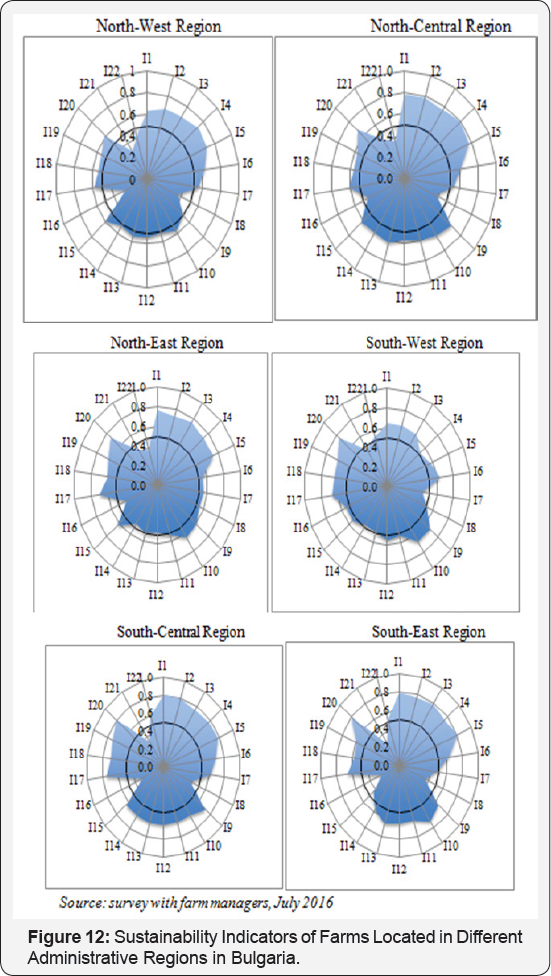
The farms located mainly in Plain Regions of the country have best indicators for environmental sustainability in respect to: Nitrate and Pesticide Content in Surface and Ground Waters, Extent of Air Pollution, Extent of Application of Good Agricultural Practices, and application of Norms of Nitrogen Fertilization. At the same time, these type of holdings are low sustainable in respect to: Type of Manure Storage (0,29), Number of Livestock per ha (0,3), Extent of Respecting Animal Welfare (0,37), Irrigation Rate (0,42), Number of Wild Species on the Territory of the Farm (0,48), and at the border with a low level for Adaptability to Natural Environment (0,5). In addition they have insufficient Efficiency of Supply and Governance of Short-term (0,28) and Long-term (0,49) Inputs, and Innovations (0,49), Livestock Productivity (0,28), and Rate of Profitability of Own Capital (0,45).The farms located in Plain-Mountainous Regions of the country are with the best indicators for environmental sustainability in following areas: Nitrate and Pesticide Content in Surface and Ground Waters, Extent of Application of Good Agricultural Practices, Extent of Air Pollution, and Extent of Preservation of Quality of Ecosystem Services.
Nevertheless, this category of farms are low environmentally sustainable in regard to: Number of Livestock per ha (0,36), Type of Manure Storage (0,39), Irrigation Rate (0,39), application of Norm of Potassium Fertilization (0,47), efficient Crop Rotation (0,47), Extent of Water Erosion (0,49), and Extent of Respecting Animal Welfare (0,44). Furthermore, some indicators of that farming type are on the border with a low sustainability level like: Soil Acidity, application of Norm of Phosphorus Fertilization, and Extent of Wind Erosion. In addition, these holdings they have low Adaptability to Natural Environment (0,45), Efficiency of Supply and Governance of Short-term Inputs (0,26) and Natural Resources (0,49), Livestock Productivity (0,33) and Land Productivity (0,49), Rate of Profitability of Own Capital (0,35), Overall Liquidity (0,43), Financial Autonomy (0,48), and Income per Farm-household Member (0,48), and close to inferior level Efficiency of Supply and Governance of Finance and Innovations.
The farms located mainly in Mountainous Regions of the country have relatively a high levels of environmental sustainability, particularly for: Extent of Preservation of Quality of Ecosystem Services, Nitrate and Pesticide Content in Surface and Ground Waters, Extent of Air Pollution, Extent of Application of Good Agricultural Practices, Number of Cultural Species, and Number of Wild Species on the Territory of the Farm. Simultaneously, this holdings are insufficient eco-sustainable for Type of Manure Storage (0,48) and have low governance and economic sustainability in relations to: Efficiency of Supply, and Governance of Short-term Inputs (0,29) and Natural Resources (0,47), Rate of Profitability of Own Capital (0,37), Overall Liquidity (0,47), and Financial Autonomy (0,46), The farms with Lands in Protected Zones and Territories are with high environmental sustainability in respect to: Extent of Air Pollution while simultaneously have good levels for Extent of Preservation of Quality of Ecosystem Services, Nitrate and Pesticide Content in Surface and Ground Waters, Extent of Application of Good Agricultural Practices, application of Norms of Nitrogen, Phosphorus and Potassium Fertilization, and Soil Organic Content. On the other hand, that category of holdings are relatively low eco-sustainable in regard to Extent of Respecting Animal Welfare (0,43), Number of Wild Species on the Territory of the Farm (0,46), and Number of Livestock per ha (0,48). In addition they have love Efficiency of Supply and Governance of Short-term Inputs (0,33).
The farms located in Mountainous Regions with Natural Handicaps have the best positive values for environmental sustainability for: Extent of Application of Good Agricultural Practices, Extent of Air Pollution, Nitrate and Pesticide Content in Surface and Ground Waters, application of Norm of Nitrogen Fertilization, Extent of Preservation of Quality of Ecosystem Services, and Soil Organic Content. At the same time, these holding are low sustainability in respect to Number of Livestock per ha (0,45) and Extent of Respecting Animal Welfare (0,47). Moreover, they are low sustainable in terms of: Efficiency of Supply and Governance of Short-term Inputs (0,29), Rate of Profitability of Own Capital (0,45), Livestock Productivity (0,46), Financial Autonomy (0,47), as well as marginal with the low level (0,5) for Efficiency of Supply and Governance of Innovations and Overall Liquidity.
The farms located in Non-mountainous Regions with Natural Handicaps are with maximal or high values for sustainability for numerous environmental indicators: practicing effective Crop Rotation, application of Norms of Nitrogen, Phosphorus and Potassium Fertilization, Extent of Application of Good Agricultural Practices, Nitrate Content in Surface Waters, Nitrate and Pesticide Content in Ground Waters, Number of Cultural Species, and Extent of Preservation of Quality of Ecosystem Services. What is more, for a number of indicators environmental sustainability levels of these holdings are at the border with a high level - Pesticide Content in Surface Waters, Number of Wild Species on the Territory of the Farm, and Soil Organic Content as well as good positive levels for Soil Acidity, and Extent of Wind Erosion. At the same time, farms located in such areas are with low sustainability regarding Extent of Respecting Animal Welfare (0,25), and Number of Livestock per ha (0 ).
Besides, they are low sustainable in terms of: Adaptability to Natural Environment (0,41), Efficiency of Supply and Governance of Short-term Inputs (0,33), Livestock Productivity (0 ), Overall Liquidity (0,33), and Satisfaction of Activity (0,33). What is more, for a number of indicators sustainability the levels are at the border with a low level - Type of Manure Storage, Rate of Profitability of Own Capital, and Income per Farm-household Member. Finally, there is also a differentiation of levels of environmental sustainability off arms in different administrative (geographical) regions of the country (Figure 12). For the farms located in the North-West Region of the country the best values of environmental sustainability indicators are for the Nitrate and Pesticide Content in Surface and Ground Waters, Extent of Air Pollution, and Number of Cultural Species. At the same time, environmental sustainability of holdings in this region is low in respect to the Extent of Respecting Animal Welfare (0,35), Number of Livestock per ha (0,25), Type of Manure Storage (0,3) and Irrigation Rate (0,4).
Besides, at marginal with a low level is the indicator Extent of Preservation of Quality of Ecosystem Services. In addition, there are a number of inferior socio-economic and governance areas of farms sustainability in that region: Adaptability to Natural Environment (0,48), Efficiency of Supply and Governance of Short-term Inputs (0,36), Natural Resources (0,44), and Innovations (0,46), Livestock Productivity (0,28), Income Return of Enterprise (0,45), Rate of Profitability of Own Capital (0,43), Overall Liquidity (0,44), Financial Autonomy (0,39), and Contribution to Preservation of Rural Communities and Traditions (by 0,47). The farms located in the North-Central Region of the country are with numerous superior indicators for environmental sustainability including: Nitrate and Pesticide Content in Surface and Ground Waters, Extent of Air Pollution, Extent of Preservation of Quality of Ecosystem Services, and Extent of Application of Good Agricultural Practices. At the same time, they are low sustainable in regard to the Extent of Respecting Animal Welfare (0,38), Number of Livestock per ha (0,44), Type of Manure Storage (0,42) and Irrigation Rate (0,36). Moreover, Efficiency of Supply and Governance of Shortterm Inputs (0,25), Livestock Productivity (0,36), is Rate of Profitability of Own Capital (0,46) is at a low level, while the Overall Liquidity at the border with a low level.
The farming holdings located in the North-East Region of the country are with good environmental sustainability indicators for: Nitrate and Pesticide Content in Surface and Ground Waters, Extent of Application of Good Agricultural Practices, Extent of Air Pollution, and Norm of Nitrogen Fertilization. On the other hand, they are low sustainable regarding the Number of Livestock per ha (0,41), Extent of Water Erosion (0,47), and Soil Soltification (0,49), while their Irrigation Rate is close to the low sustainability level. Furthermore, their Adaptability to Natural Environment (0,43), Efficiency of Supply and Governance of Short-term (0,27) and Long-term (0,45) Inputs, Labor Resources (0,48), Livestock Productivity (0,4), Rate of Profitability of Own Capital (0,27), Overall Liquidity (0,42), and Financial Autonomy (0,49), and Income per Farm-household Member (0,46), are all at a low levels, while the Efficiency of Supply and Governance of Finance at the border of the inferior level.
The farms located in the South-West Region of the country are with a low environmental sustainability regarding the Number of Wild Species on the Territory of the Farm (0,42), Extent of Wind (0,49) and Water (0,48) Erosion, and Type of Manure Storage (0,45). Moreover, their governance and economic sustainability is inferior in a number of areas such as: Efficiency of Supply and Governance of Short-term Inputs (0,26) and Natural Resources (0,44), Livestock Productivity (0,48), Rate of Profitability of Own Capital (0,37), Overall Liquidity (0,4), and Financial Autonomy (0,42). Simultaneously, for the holding is that region the best environmental indicators are for the Extent of Application of Good Agricultural Practices, Extent of Preservation of Quality of Ecosystem Services, Soil Organic Content, application of Norm of Nitrogen Fertilization, and Nitrate Content in Surface Waters.
The best values of environmental sustainability indicators of the farms located in the South-Central Region of the country are: Extent of Application of Good Agricultural Practices, Nitrate and Pesticide Content in Surface and Ground Waters, Extent of Air Pollution, application of Norms of Nitrogen, Phosphorus, and Potassium Fertilization, and Extent of Preservation of Quality of Ecosystem Services. At the same time, holdings within the region have low values for indicators for eco-sustainability related to the livestock operations - Extent of Respecting Animal Welfare (0,38), Number of Livestock per ha (0,3), and Manure Storage (0,34). On the top of that, farms are low sustainable in respect to the Efficiency of Supply and Governance of Short-term Inputs (0,25), Livestock Productivity (0,23), Rate of Profitability of Own Capital (0,42), and are at marginal to a low level for Efficiency of Supply and Governance of Finance (0,5).
The farms located in South-East Region of the have very good levels for a number of environmental indicators like: Extent of Application of Good Agricultural Practices, Extent of Air Pollution, Nitrate and Pesticide Content in Surface and Ground Waters, and Soil Organic Content. However, holdings in the region are low eco-sustainable for the Number of Livestock per ha (0,25), Type of Manure Storage (0,28), Extent of Respecting Animal Welfare (0,36), application of efficient Crop Rotation (0,43), and Number of Wild Species on the Territory of the Farm (0,47). In addition, they have insufficient governance and socioeconomics sustainability regarding Efficiency of Supply and Governance of Short-term Inputs (0,28), Innovations (0,48), and Natural Resources (0,49), Livestock Productivity (0,33), and Contribution to Preservation of Rural Communities (0,48), and they are on the border with a low level (0,5) for Adaptability to Natural Environment, and Income per Farm-household Member.
Share of Farms with Different Levels of Environmental Sustainability

The overall levels of environmental sustainability of Bulgarian farms do not give a full picture about the state of individual holdings in the country since there is a great variation in the share of farms with different sustainability levels. The environmental sustainability of the majority of surveyed farms is good or superior, while a considerable portion is with a low sustainability (18%) or environmentally unsustainable (4%) (Figure 13). The latter two figures clarify that environmental efficiency in a large number of Bulgarian farms do not meet contemporary norms and standards for preservation of lands, waters, air, biodiversity, ecosystem services, and animal welfare. A big share of the Companies and a good number of the Physical Persons and the Cooperatives are with a high environmental sustainability, while the majority of holdings in these categories are with a good eco-sustainability.
Despite that, a main portion of the latter farms is with a low sustainability (accordingly 24%, 18% and 23%), as every twentieth of the Physical Persons is even environmentally unsustainable. All of the Sole Traders are with a good level of environmental efficiency. The largest is the portion of the farms with good and high eco-sustainability among holdings Predominately for Subsistence, with Small size for the sector, and big farms. The greatest part of the holdings with a low or unacceptable environmental sustainability is in the groups of the Middle and Big sizes. The fraction of strongly environmentally sustainable farms is significant among those specialized in the Crop-Livestock, Grazing Livestock, Mix Crops, and Permanent Crops. All holdings specialized in the Pigs, Poultry and Rabbits, most of those in the Mix Crops, and by three-quarters in the Crop-Livestock and the Permanent Crops are with a good environmental sustainability.
At the same time a considerable portion of the farms specialized in the Vegetables, Flowers, and Mushrooms are with a low eco-sustainability (32%) or eco-unsustainable (14%), similarly to those in the Mix Livestock (accordingly 29% and 14%) and Field Crops (accordingly 31% and 3%). The number of environmentally unsustainable farms is also considerable among those specialized in the Permanent Crops (a little more than 7%) as well as of low sustainable among those in the Grazing Livestock. All farms located in the Non-mountainous Regions with Natural Handicaps are with a good environmental sustainability as well as most with the Lands in Protected Zones and Territories. The biggest share of holdings with a high ecosustainability is in the Plain Mountainous and Mountainous Regions as well as in the Mountainous Regions with Natural Handicaps. At the same time, the greatest fractions of farms with a low eco-sustainability or environmentallyunsustainable are in the Plain-Mountainous (26%) and the Plain (25%) Regions as well as in the Mountainous Regions with Natural Handicaps (19%). The biggest part of holdings with a high and good eco-sustainability is in the North-Central and the South-Central Regions of the country while of these with a low ecosustainability or eco-unsustainable in the South-West, NorthWest, South-East and North-East Regions.
All these data indicates, that a good number of Bulgarian farms are with a low eco-sustainability or environmentally unsustainable, which also compromises their overall longterm sustainability. Therefore, effective measures have to be undertaken to improve eco-efficiency in these groups through training, informing, stimulation, sanctions, etc. Structures of farms with different integral sustainability level is quite different from the structure of holdings with unlike environmental sustainability in the country due to the variations of governance, economic, social sustainability in individual holdings (Figure 14). Therefore, it has to be taken account to shares of farms with different overall sustainability as well in order to understand the state and prospects of farming development.
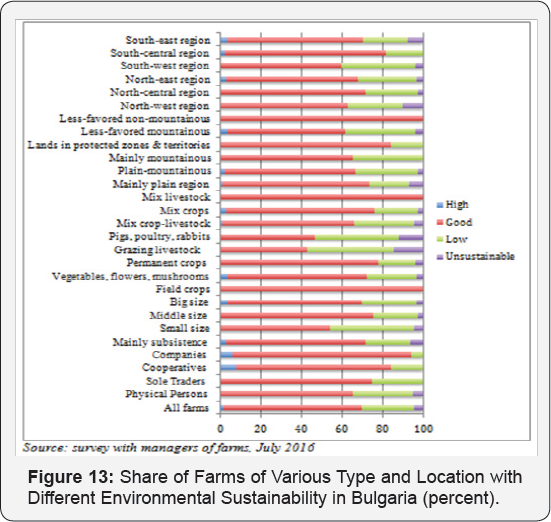
While the biggest portion of the Bulgarian farms is with a good sustainability (and only under 2% with a high sustainability), as much as 30% of all agricultural holdings in the country are with a low sustainability or unsustainable at all. Analysis of the structure of farms with different level of sustainability for each aspect gives important information about the long-term sustainability of farms and factors for its improvement. For instance, our assessment shows that 40% of holdings in the country are with a low governance sustainability or managerially unsustainable. That means that the comparative governance efficiency for supply of labor, land, finance, etc. and/ or marketing of produce in these farms is lower than another feasible organization, and that the adaptability to evolving socioeconomic, institutional and natural environment is insufficient. Therefore, a considerable fraction of the Bulgarian farms are with insufficient governance sustainability for meeting contemporary socio-economic, institutional and natural challenges, and they have to modernize or they will cease to exists in a middle term.
Similarly, 42% of all farms are with a low economic sustainability or unsustainable at all. That means that economic and financial efficiency of activity and resource utilization in a good portion of Bulgarian farms is low and do not correspond to the modern management and competition requirements. All these indicates that, a great part of Bulgarian farms currently are with low economic sustainability or economically unsustainable, and most likely they will cease to exists in near future or in coming years, unless effective measures are taken (public support regulations, etc.) for improving their economic sustainability. As far as the social aspect of sustainability is concerned the majority of surveyed farms in the country are with a good or high sustainability. Despite that holdings with a low social sustainability are numerous (almost 18%), and each tenth one is socially unsustainable. That demonstrates that social efficiency of agricultural holdings for farmers, communities and society and a whole do not correspond to contemporary requirements and standards. A good portion of Bulgarian farms currently are with a low social sustainability or socially unsustainable, which compromises their overall middle and long-term sustainability. Therefore, effective measures have to be undertaken to improve income, labor and living conditions of farmers and farm households as well as their importance for preservation of rural communities and traditions.
The greatest share of farming enterprises with a good and high integral sustainability is among Companies, following by Cooperatives, and Sole Traders, The smallest is the fraction of holdings with a good sustainability among Physical Persons, where merely less than 1% is highly sustainable. Furthermore, more than a third of latter holdings are with a low sustainability or unsustainable at all. Every forth of Sole Traders is with a low sustainability, like 15% of Cooperatives, while only 6% of Companies are in the group of low sustainable enterprises. There are also considerable differences in the portion of farms with unlike sustainability depending on the size of holdings. While all farms with Big size for the sectors are with a good sustainability, more than a half of holdings Predominately for Subsistence are with a low sustainability or unsustainable. Around a third of farms with Small size and almost a quarter of those with Middle size are with a low sustainability or unsustainable. Among farms with diverse specialization, the share of holdings with a good and high sustainability is the greatest for Pigs, Poultry and Rabbits, Mix-crops, Permanent Crops, Mix Crop-livestock, Field Crops and Grazing Livestock. On the other hand, majority of holdings in Mix-livestock are with a low sustainability (43%) or unsustainable (14%). A good portion of the farms specialized in Vegetables, Flowers and Mushrooms is also low sustainable (41%) or unsustainable (4%).
The share of farms with a good and high sustainability is significant among those located in Non-mountainous Regions with Natural Handicaps, with Lands in Protected Zones and Territories, in Plain Regions, in South-Central, North-Central, and South-East Regions of the country. Simultaneously, 40% of holdings in South-West Region with low sustainability or unsustainable, similar to 37% of those in North-West and 32% in North-East Region. North-West Region is the leader in segment of unsustainable farms, where every tenth is unsustainable. Many holdings in Mountainous Regions with Natural Handicaps (38%), and Mountainous Regions (35%), and a third in Plain- mountainous Regions are low sustainable or unsustainable. Data for dispersion of farms of different type in groups with diverse level of aspect and integral sustainability has to be taken into account when forecast the number and importance of holdings of each kind, and modernize public (structural, sectorial, regional, environmental, etc.) policies for supporting agricultural producers of certain type, sub-sectors, eco-systems, and regions of the country.
Conclusion
Suggested holistic framework gives a possibility to improve assessment, analysis and management of environmental sustainability of individual farms and holdings of different type. That approach has to be further discussed, experimented, improved and adapted to the specific conditions of operation and development of farms of different type, subsector of production, geographical region and ecosystem as well as the special needs of decision-makers at various levels. The overall and the environmental sustainability of Bulgarian farms are at good levels, with superior levels for environmental and social sustainability, and inferior level for governance and economic sustainability. Thus improvement of the latter two is critical for maintaining overall sustainability of Bulgarian farming holdings.
Despite that the overall environmental sustainability is relatively high; Preservation of Agricultural Lands and Biodiversity are relatively low and critical for maintaining the achieved sustainability level as insufficient Application of Recommended Irrigation Norms, a high level of Soils Water Erosion, and lowered Number of Wild Animals on farm territory determining the latter inferior levels. Furthermore, insufficient levels of governance and economic sustainability in a number of critical areas (pre)affect the overall sustainability of farms in the country.
There are great variations in integral and environmental sustainability levels of farms of different type and location as well as in shares of holdings with unlike level of sustainability. Distribution of farms of different type in groups with diverse levels of sustainability has to be taken into account when forecast the number and importance of holdings of each kind, and modernize public (structural, sectorial, regional, environmental, etc.) policies for supporting agricultural producers of certain type, sub-sectors, eco-systems and regions of the country.
Having in mind the importance of holistic assessments of environmental and integral sustainability of farms, and the enormous benefits for the farm management and agrarian policies, such studies are to be expended and their precision and representation increased. The latter require a close cooperation between all interests parties and participation of farmers, agrarian organizations, local and state authorities, interest groups, research institutes and experts, etc. Moreover, the precision of estimates has to be improved and besides on assessments of managers to incorporate relevant information from field tests and surveys, statistical and other data, and expertise of professionals in the area.
References
- Andreoli M, V Tellarini (2000) Farm sustainability evaluation: methodology and practice Agriculture. Ecosystems & Environment 77(1-2): 43-52.
- Bachev H (2005) Assessment of Sustainability of Bulgarian Farms proceedings. It Congress of the European Association of Agricultural Economists Copenhagen, Europe, p. 1-47.
- Bachev H (2010) Governance of Agrarian Sustainability New York. Nova Science Publishers,USA.
- Bachev H, Koteva N, K Kaneva, D Terziev, D Vanev (2016) Sustainability of Bulgarian Farms during Reformed CAP Implementation. Proceedings of International Conference "Fostering agriculture innovation and business opportunities for rural renaissance”, Sofia, Europe, p. 27-28.
- Bastianoni S, N Marchettini, M Panzieri, E Tiezzi (2001) Sustainability assessment of a farm in the Chianti area (Italy). Journal of Cleaner Production 9(4): 365-373.
- EC (2001) A Framework for Indicators for the Economic and Social Dimensions of Sustainable Agriculture and Rural Development. European Commission, Europe, p. 1-39.
- FAO (2013) SAFA Sustainability Assessment of Food and Agriculture systems indicators. FAO
- Fuentes M (2004) Farms Management Indicators Related to the Policy in the European Union. OECD Expert Meeting on Farm Management Indicators and the Environment, New Zealand.
- Hani F, L Pinter, H Herren (2006) Sustainable Agriculture from Common Principles to Common Practice. Proceedings of the first Symposium of the International Forum on Assessing Sustainability in Agriculture (INFASA), Switzerland, pp. 1-262.
- OECD (2001) Environmental indicators for agriculture. Methods and Results, OECD, Paris.
- Rigby DP, Woodhouse, T, Young M, Burton (2001) Constructing a farm level indicator of sustainable agricultural practice. Ecological Economics 39(3): 463-478.
- Sauvenier X, J Valekx, N Van Cauwenbergh, E Wauters, H Bachev, et al. (2005) Framework for Assessing Sustainability Levels in Belgium Agricultural Systems-SAFE. Belgium Science Policy Brussels, Belgium, pp. 1-126.
- UN (2015) Transforming our world the 2030 Agenda for Sustainable Development. United Nations Resolution.
- Bachev H, A Peeters (2005) Framework for Assessing Sustainability of Farms in Farm Management and Rural Planning No 6. Kyushu University, Fukuoka, Japan, pp. 221-239.
- Bachev H (2017a) Sustainability of Bulgarian Farming Enterprises during EU CAP Implementation. Journal of Applied Economic Sciences 2(48): 422-451.
- Bachev H (2017b) Sustainability Level of Bulgarian Farms. Bulgarian Journal of Agricultural Science 23 (1): 1-13.






























